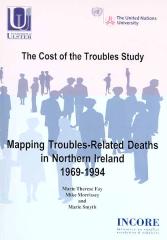
Abstract from 'Mapping Troubles-Related Deaths in Northern Ireland 1969-1994'[KEY_EVENTS] [Key_Issues] [Conflict_Background] VIOLENCE: [Menu] [Reading] [Summary] [Background] [Chronology] [Incidents] [Deaths] [Main_Pages] [Statistics] [Sources] The Cost of the Troubles Study: [Menu] Material is added to this site on a regular basis - information on this page may change The following has been contributed by the authors with the permission of the publishers. The views expressed do not necessarily reflect the views of the members of the CAIN Project. The CAIN Project would welcome other material which meets our guidelines for contributions.  Mapping Troubles-Related Deaths in Northern Ireland
Mapping Troubles-Related Deaths in Northern Ireland
By:
Published by:
Orders to:
This material is copyright of the authors 1997 and is included on
the CAIN site by permission of the publishers. You may not edit, adapt,
or redistribute changed versions of this for other than your personal use
without the express written permission of the publishers. Redistribution
for commercial purposes is not permitted.
This paper describes the compilation
of a database on deaths in the Troubles in Northern Ireland, which
includes deaths which have occurred outside Northern Ireland and
deaths due to Troubles-related trauma. Existing data sources on
deaths in the Troubles are reviewed and analysed. Analysis of
the newly compiled database has confirmed many of the findings
and trends identified by others in previous work, if not in the
numbers of deaths, then certainly in the high levels of death
in the first half of the 1970's. Analysis of the new database
has not supported the suggestion that deaths peak in the summer
months, but rather October and November have emerged as the months
with the highest death rates. Different cycles emerged among
the organisations principally responsible for killings, with peaks
of activity occurring at different points in the period 1969 -
1994. In terms of the distribution of deaths, the overwhelming
majority of those killed in the Troubles have been male, with
the death risk highest in the younger age groups in the 20-24
age group highest, and almost 26 percent of all victims aged 21
or less. Both in absolute and relative terms more Catholics than
Protestants have been killed, and the death rate for Catholics
is greater than that for Protestants, as other researchers have
found. However, if we include Northern Ireland security forces
deaths in the analysis, and exclude Catholics killed by Republican
paramilitaries and Protestants killed by Loyalist paramilitaries,
the death rates move somewhat closer: - 2.5 per 1,000 for Catholics
and 1.9 per 1,000 for Protestants. Civilians are the largest
category killed, and account for 53 percent of the total killed,
with the British Army accounting for almost 15 pre cent. Republican
paramilitaries account for almost 13 percent, the RUC account
for 8 percent of those killed and the other groups each account
for less than 6 per cent. In relation to perpetration of killings,
Republican paramilitaries account for almost 59 per cent of all
deaths, Loyalist paramilitaries for almost 28 per cent, the British
Army for 9 per cent, the RUC for almost 2 per cent and other groups
each for less than 1 per cent. Republican paramilitaries have
killed 74 per cent of all Protestants killed, over 25 per cent
of all Catholics, and almost 96 per cent of those who were classified
as "Non Northern Ireland." Loyalist paramilitaries
killed 19 per cent of all Protestants killed, almost 50 per cent
of all Catholics and just 2 per cent of the "Non Northern
Ireland " category. On the distribution of deaths, a death
rate by ward was calculated and a concentration of deaths was
found in Belfast, with only 15 of the 57 highest ranking wards
outside the Belfast area. Derry Londonderry and Armagh account
for most of the remaining wards.
The distribution of deaths in the Troubles
was correlated with the Robson deprivation indicator, and whilst
the wards with the highest death rates also score high on the
Robson index, no overall statistical association between death
rate and deprivation was found. The percentage change in the
yearly death rate was correlated with changes in the Northern
Ireland GDP and the numbers unemployed. Whilst a negative correlation
was found between death rates and GDP, and a positive correlation
between deaths and unemployment, this is probably spurious. Finally,
deaths in the Troubles was compared with the annual suicide figures
for Northern Ireland, and a negative correlation found, suggesting
that suicide rose as deaths in the Troubles decreased. This is
somewhat consistent with evidence from elsewhere and merits further
investigation. Whilst the findings generally support those of
earlier work, the assertion that the spatial distribution of deaths
is associated with the spatial concentration of Catholics was
not confirmed. Variations of between 5-10% were found in the
total number of deaths found between the new database and previously
existing lists. Assertions that the intensity of the Troubles
meant that they ranked among the most serious of the world conflicts
was not supported by preliminary international comparative work.
Future work will re-examine the relationship
between deprivation and the spatial distribution of Troubles-related
deaths, the relationship between economic trends and the
Troubles and further work on mental health aspects will be conducted.
New data on mental health, economic and other aspects of the
effects of the Troubles will be generated by a survey of a sample
of the population of Northern Ireland.
See also: Background information on The Cost of the Troubles Study Ltd. Selected tables from 'Mapping Troubles-Related Deaths in Northern Ireland 1969-1994'
|
CAIN
contains information and source material on the conflict
and politics in Northern Ireland. CAIN is based within Ulster University. |
|
|
|||
|
Last modified :
|
||
|
| ||